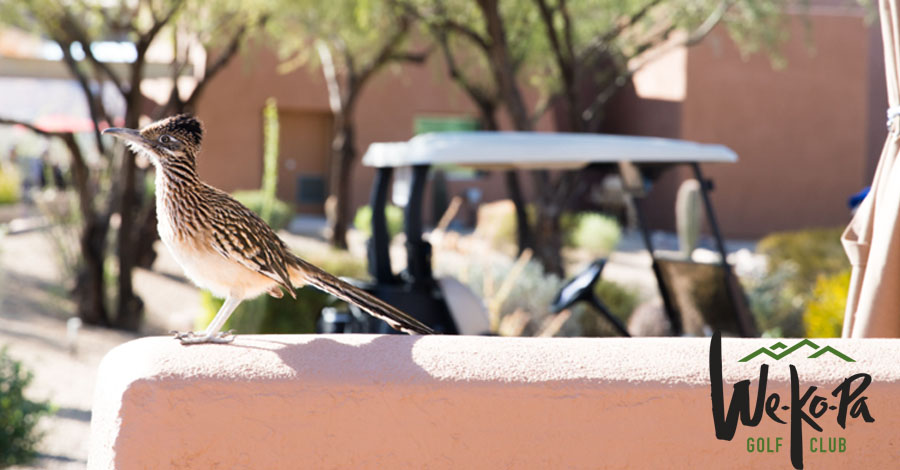Even if your only knowledge of the Roadrunner is from the popular Saturday morning cartoons featuring a bumbling, self-appointed-genius coyote, you’re likely at least somewhat familiar with this particular sprinting bird. And if you’re planning on playing either of We-Ko-Pa’s award-winning courses just outside Scottsdale in Fort McDowell, Arizona, you’re almost guaranteed to catch a glimpse of this desert icon. They’re everywhere and they’re fast.
Desert Roadrunners (genus Geococcx) are also known as chaparral birds in other parts of the world, but you will rarely hear that name here in the Sonoran Desert. They are roughly two-feet in length from tail to beak – much larger than most visitors anticipate – and feature a slender, black-brown and white streaked body with a distinctive and colorful head crest. The Roadrunner’s long legs, strong feet and aerodynamic frame allow it to reach speeds of up to 27 mph at full sprint. For a jaw-dropping perspective, the average Roadrunner at We-Ko-Pa could line up and take second place against Usain Bolt in the 100M at the 2009 World Championships in Berlin – the fastest recorded human speed in history. Now that’s fast, especially for an animal only 18 inches off the ground.
Roadrunners are opportunistic omnivores with a diet normally consisting of insects, small reptiles like lizards, small mammals and arachnids like spiders and scorpions. And while they don’t have the ability to use cash at the We-Ko-Pa Grille to buy chips or hot dogs like us, they don’t view humans as predators which makes them capable of stealing an unguarded lunch with ease. Keep that in mind when getting a bite at the turn. And their incredible speed makes them one of the few animals fast enough to catch and eat rattlesnakes – the small ones anyway – keeping an apex predator of the desert in check.
Roadrunners also are one of the few animals to feature monogamous relationships. Those lucky enough to find a partner routinely mate for life and hold hunting territory together all year. Their nests are fairly common compared to other bird species and are generally 4-10 feet above the ground – often in arms of the iconic Saguaro Cactus out at We-Ko-Pa.
With extremely limited predators, incredible speed and a general unwariness of humans, Roadrunners are one of, if not the most common animals found at We-Ko-Pa Golf Club. It’s a safe bet you’ll get a chance to see at least one the next time you book a round at either Cholla or Saguaro, but more than likely, you’ll see the resident Roadrunner outside service employee who likes to hang around the bag drop. He doesn’t have a name just yet. Maybe our guests can help us out with that.







